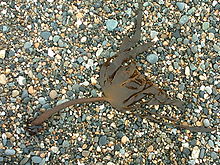
Arame, sea oak is a species of kelp, of the brown algae, best known for its use in Japanese cuisine.
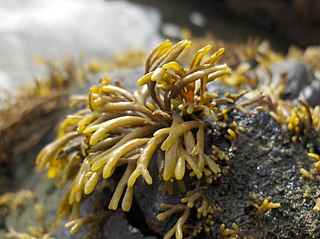
Pelvetia canaliculata, the channelled wrack, is a very common brown alga (Phaeophyceae) found on the rocks of the upper shores of Europe. It is the only species remaining in the monotypic genus Pelvetia. In 1999, the other members of this genus were reclassified as Silvetia due to differences of oogonium structure and of nucleic acid sequences of the rDNA.
Karl Ludwig Philipp Zeyher, was a botanical and insect collector who collected extensively in South Africa. He was the author, with Christian Friedrich Ecklon, of Enumeratio Plantarum Africae Australis (1835-7), a descriptive catalogue of South African plants.
Christian Friedrich Ecklon was a Danish botanical collector and apothecary. Ecklon is especially known for being an avid collector and researcher of plants in South Africa.
Thorea is a genus of freshwater algae in the Phylum Rhodophyta. Thorea is a small alga with filaments up to 200 cm long, dark green in colour and not red as are marine Rhodophyta. The filaments have only as few secondary branches.

Schroederia is a genus of green algae in the family Schroederiaceae. Schroederiaceae is a monotypic taxon; Schroederia is its only genus.
Struveopsis is a genus of green algae in the family Boodleaceae.

Trentepohlia is a genus of filamentous chlorophyte green algae in the family Trentepohliaceae, living free on terrestrial supports such as tree trunks and wet rocks or symbiotically in lichens. The filaments of Trentepohlia have a strong orange colour caused by the presence of large quantities of carotenoid pigments which mask the green of the chlorophyll.
Geppella is a genus of green algae in the family Codiaceae.
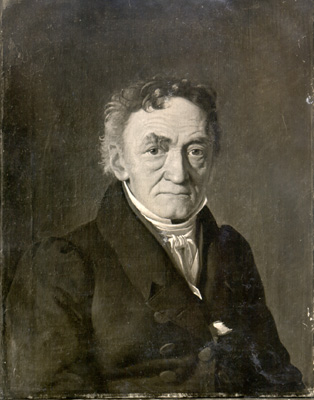
Jens Wilken Hornemann was a Danish botanist.
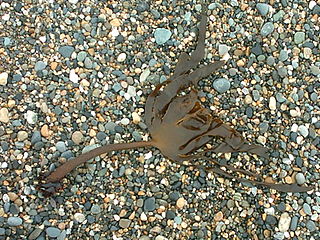
Ecklonia cava, is an edible marine brown alga species found in the ocean off Japan and Korea.
Unio Itineraria was a German scientific society which was based at Esslingen am Neckar in Baden-Württemberg, Germany. The organisation paid botanists to travel and collect plants, and sold the collections in large sets. Rising costs associated with the Wilhelm Schimper expeditions led to the collapse of Unio Itineraria in 1842. Significant portions of the Unio Itineraria collections were directed to Herbarium Tubingense at the University of Tübingen in Baden-Württemberg

Morten Wormskjold was a Danish botanist and explorer. He collected plants in Greenland and Kamchatka. The standard author abbreviation Wormsk. is used to indicate this person as the author when citing a botanical name.
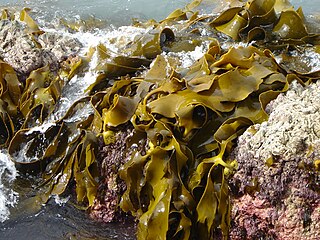
Phlorotannins are a type of tannins found in brown algae such as kelps and rockweeds or sargassacean species, and in a lower amount also in some red algae. Contrary to hydrolysable or condensed tannins, these compounds are oligomers of phloroglucinol (polyphloroglucinols). As they are called tannins, they have the ability to precipitate proteins. It has been noticed that some phlorotannins have the ability to oxidize and form covalent bonds with some proteins. In contrast, under similar experimental conditions three types of terrestrial tannins apparently did not form covalent complexes with proteins.

Eckol is a phlorotannin isolated from brown algae in the family Lessoniaceae such as species in the genus Ecklonia such as E. cava or E. kurome or in the genus Eisenia such as Eisenia bicyclis.
Hans Christian Lyngbye was a Danish priest and botanist, specialising in algae.

Jania is a genus of red macroalgae with hard, calcareous, branching skeletons in the family Corallinaceae.
Ecklonia stolonifera is a brown alga species in the genus Ecklonia found in the Sea of Japan. It is an edible species traditionally eaten in Japan.

Casimir Roumeguère was a French botanist and mycologist.
Wislouchia is a genus of chlorophyte green algae. The name was first published in 2021, as a replacement name for Raciborskiella. As of February 2022, it was the only genus in the family Wislouchiaceae.
